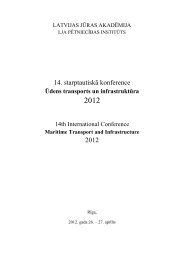Latvian Maritime academy
Latvian Maritime academy
Latvian Maritime academy
You also want an ePaper? Increase the reach of your titles
YUMPU automatically turns print PDFs into web optimized ePapers that Google loves.
Levels of education are also used to refer to the provision of education, for example, in UNESCO’s<br />
International Standard Classification of Education (ISCED), which is primarily a tool for statistical<br />
classification [6]. The ISCED has nine reference levels of qualification from 0 to 8 (Table 1).<br />
Table 1. Hierarchy between qualifications granted by tertiary education programmes specified in ISCED [6]<br />
Level of HE Cycle of HE Duration of studies<br />
Level 5 Short-cycle tertiary programmes At least 2 years<br />
Level 6 Bachelor or equivalent first degree programmes 3-4 years<br />
Level 6 Bachelor or equivalent long first degree programmes More than 4 years<br />
Level 7 Master or equivalent long first degree programmes At least 5 years<br />
Level 8 Doctoral or equivalent ISCED n/a<br />
Levels and content of competence in context of European Qualifications Framework<br />
The European Qualifications Framework (EQF) [7] was formally adopted by the European<br />
Parliament and the Council on 23 April 2008 as a recommendation, which assists in comparing the<br />
national qualifications systems [8]. The objective of this Recommendation is to create a common<br />
reference framework which should serve as a translation device between different qualifications systems<br />
and their levels, whether for general and higher education or for vocational education and training. The<br />
EQF has eight reference levels of qualification, including general education, vocational training and<br />
higher education. Four of them (from 5 to 8) correspond to higher education system (Annex).<br />
In accordance with EQF competence is the proven ability to use knowledge, skills and personal,<br />
social and/or methodological abilities in work or study situations and in professional and personal<br />
development (Figure 4). In the context of the European Qualifications Framework, competence is<br />
described in terms of responsibility and autonomy.<br />
Competence<br />
Ability to use<br />
knowledge<br />
Ability to use<br />
skills<br />
Personal<br />
abilities<br />
Social<br />
abilities<br />
Methodological<br />
abilities<br />
Figure 4.Competence elements in the context of European Qualifications Framework<br />
Correspondence between levels of seafarers’ competence and levels of education<br />
Analysis and comparison of European Qualifications Framework levels of competence and<br />
comparison with levels of competence (responsibility) specified by STCW 78 reveals clear<br />
correspondence between levels of competence of seafarers and adequate levels of education (Table 2).<br />
Table 2. Correspondence between levels of seafarers’ competence and adequate levels of education<br />
Levels of competence<br />
specified by EQF<br />
Corresponded levels of education Levels of responsibility (competence)<br />
specified by STCW 78<br />
Level 4 Abitur, vocational school diploma Support level (rating)<br />
Level 5 Short cycle diploma Operational level officer<br />
Level 6 Bachelor Degree Management level officer, chief engineer,<br />
master<br />
Level 7 Master of Science Degree Lecturer, researcher*<br />
Level 8 Doctor of Science Degree Lecturer, researcher*<br />
* This positions in the table are not a matter of STCW 78<br />
44
















